Each year, the developed world is flooded with complex new medical technologies, from robotic prosthetics to remote-controlled aspirin implants. Meanwhile, only about 10% of health research funds are spent addressing the pressing problems of developing nations, although these countries make up 93% of the worldwide burden of disease. In short, while a small fraction of the world pops brand-name pharmaceuticals, the majority suffers from poor sanitation, contaminated drinking water, preventable disease, and child mortality.
Naturally, this dichotomy perpetuates poverty and social inequality, according to Daniel Lustick and Muhammad Zaman, who are scholars on the topic. Says Harold Varmus, president of Memorial Sloan-Kettering Cancer Center in New York, the discrepancy of life expectancy between the five richest and five poorest countries in the world is one of the greatest disappointments in biological sciences in the 20th century. As the dichotomy between the haves and have-nots grows ever greater, many engineers are now focusing on bridging this gap by devoting themselves to developing engineering solutions for low-resource settings. Organizations like Engineering World Health are growing rapidly, as are global health engineering programs at leading colleges and universities. The mandate to improve world health is clear—four out of eight of the United Nations’ (UN’s) Millennium Development Goals pertain to global health or sanitation.
The problem is that more than 95% of health equipment used in developing nations is actually manufactured for first-world countries. The World Health Organization estimates that seven times out of ten, this equipment doesn’t work upon arrival because it’s impossible to maintain—whether due to a lack of spare parts or trained technicians. This is why many innovators will tell you that simply designing for the developing world isn’t enough: social, cultural, and economic factors pose challenges that hinder success in these markets. Instead, many engineers are looking toward a multifaceted approach that includes training local engineers in these environments and involving the end user in the many phases of design so that adaptation is ultimately achieved and sustained.
Jeremy Guest, an assistant professor of civil and environmental engineering at the University of Illinois (Figure 1), serves as the thrust leader for Sanitation and Resource Recovery for the Safe Global Water Institute, a consortium working on engineering solutions to overcome socioeconomic barriers to providing sustainable, clean water and sanitation to people in developing countries. “There are 2.5 billion people in the world without access to appropriate sanitation,” he says. “That’s more than one third of the population, so it’s an enormous challenge.”
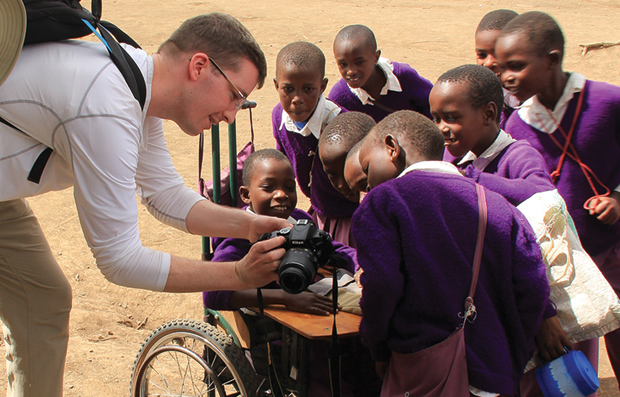
Traditionally, their approach has been to sequester and treat contaminants like bodily waste and attempt to recover resources to produce energy or to recover nutrients for agriculture. But getting the population on board with using pit latrines required for sequestration has been a struggle. “In many cases, the end users don’t necessarily see the direct benefit in using the latrines the way they are intended,” Guest says. “Not only do they not see a benefit to not defecating in the open, but they see a greater benefit in using that facility for some other function.” As Guest explains, a latrine is raised off the ground with concrete, and it has a locking door. “People see that as valuable space for storing grain, seeds, or other belongings instead of using it as a toilet,” he says.
The goal, says Guest, is to provide economic incentives in these regions so people want to manage waste properly. For this to happen, engineers must move beyond traditional design objectives and include the end user in the development of solutions. In this manner, Guest and his colleagues have been working with anaerobic membrane bioreactors to extract methane for household use out of waste water to incentivize using the latrines. “We can connect it to someone’s household and they can use it for cooking,” Guest says. “We do that because people, particularly the women who do the cooking, often have to spend a significant amount of time gathering firewood to burn, or they spend money for some fuel source to burn in the house. By having a treatment system that produces biogas, users will now save money or time. We must provide a perceived benefit.”
Bridging the Future
[accordion title=”Developing World Solutions”]
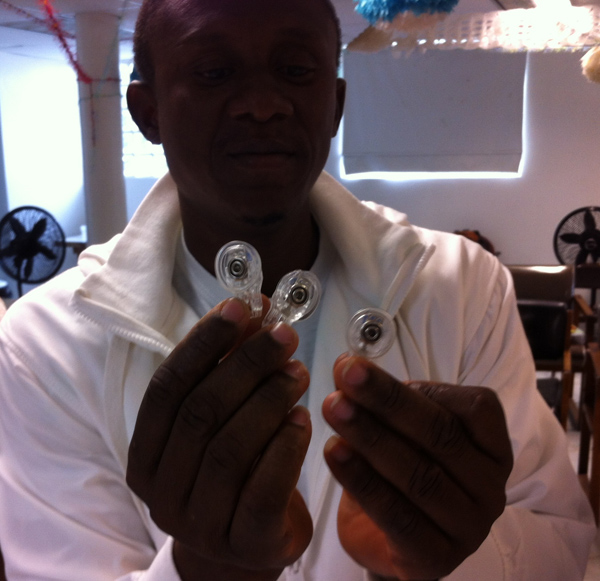
Cheap and reusable ECG pads locally constructed from beer or soda bottle caps. Bottle lid liners are removed from bottle caps, an X is cut into them and a regular metal (clothing type) snap is inserted and attached to the ECG lead line. The pad can be affixed to the patient with a homemade gel made of water, flour and salt. The pad and snap can be boiled for re-use. Photo courtesy of Robert Malkin.
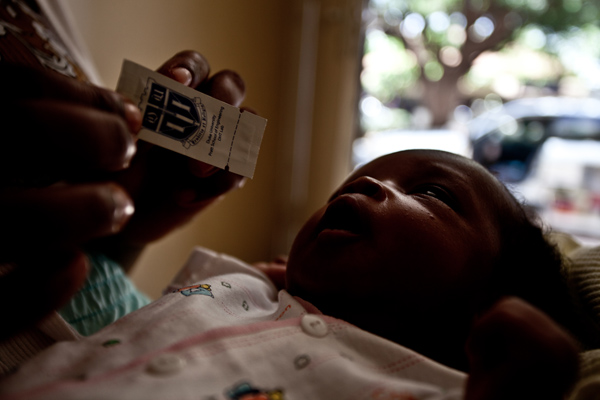
Pratt Pouch – designed by Robert Malkin and a team of 30 undergrads at Duke University, this packaging method extends the life of NVP and AZT, drugs used to prevent the transmission of HIV from mother to child. The easily portable pouch allows mothers who deliver at home to easily administer the drug to their babies. Photo courtesy of Robert Malkin.
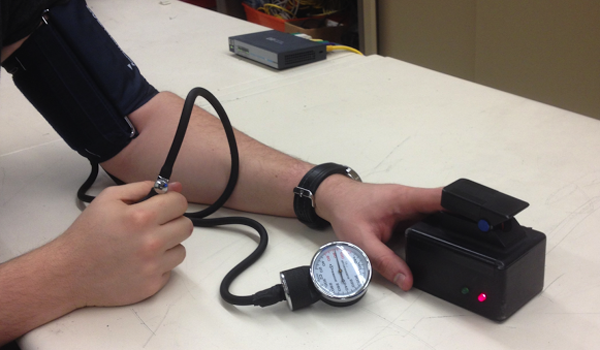
A hypertension screening device prototype – low cost and easy to use – no electricity required. Designed by Kathleen Sienko’s students in 2009. Photo courtesy of Kathleen Sienko.
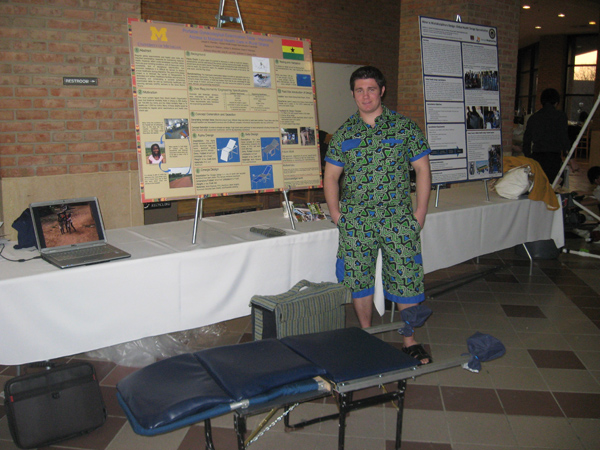
Portable Pelvic examination table. The student in the photo is University of Michigan student Joseph Perosky. Photo courtesy of Joseph Perosky.
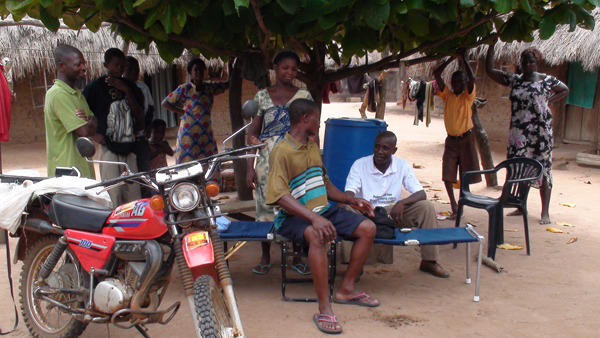
Portable gynecological examination table prototype, being put to the test in Tator Bator Village, Sene District, Ghana. Photo is courtesy of Joseph Perosky.
[/accordion]
In 2006, mechanical and biomedical engineering professor Kathleen Sienko went to Delhi, India, in an attempt to better understand the health care delivery system in the developing world and the use of technology within it. At the time, she was a Ph.D. candidate at the Massachusetts Institute of Technology (MIT) and Harvard University, studying medical engineering and bioastronautics. During the six-week clinical-immersion experience, she rotated through the All India Institute of Medical Sciences and the Rockland Hospital in New Delhi, where it wasn’t uncommon to see extrapulmonary tuberculosis, malaria, women with severe vaginal infections, and experimental robotic surgeries, all in the same day. Some clinicians, she says, saw upward of 100 patients during a four-hour-long outpatient clinic rotation.
Sienko found it fascinating to observe how the Indian medical system manages to serve 1 billion (mostly uninsured) people—40% of whom lived below the poverty line at the time. Perhaps the largest takeaway was the affirmation that the involvement of the end user is imperative in developing technologies for low-resource populations, a notion she’s been reinforcing over the past seven years as a faculty member at the University of Michigan, where she began teaching in 2007.
“I took the job with the intention of creating opportunities and developing programs that would enable undergraduate students to have clinical-immersion experiences like the one I had,” she says. Upon her arrival at the University of Michigan, one of her first orders of business was to create a minor specializing in global health design, and from there the curriculum grew to include graduate studies, eventually spurring a research lab focused on the design of health technologies for the developing world.
Over the years, Sienko and her students have become a connective tissue of sorts between clinical immersion and designing for low-resource settings. Her students complete design coursework and conduct clinical observation at the university before embarking on a two-month clinical-immersion experience in a developing market, much like Sienko had done in India. While abroad, each student is tasked with identifying 100 needs they’ve observed, and then selecting one for which they design a solution upon returning. “The final two weeks are dedicated to focused observations and interviews in order to establish preliminary user requirements and engineering specifications for the specific project,” she says.
A big focus for Sienko and her cohorts has been maternal health. Each day, approximately 800 women die from preventable causes related to pregnancy and childbirth, and 99% of these deaths occur in developing countries, according to the World Health Organization. Some of the many devices she and her students have engineered include a portable pelvic examination table, a cervical cancer screening simulator, a preeclampsia screening device for pregnant women and community health care workers, and a newborn resuscitation device, all while developing partnerships with multiple teaching hospitals in Ghana and Ethiopia. “Our graduate students are teaching biomedical engineering classes in these regions,” Sienko says. “In this way, we’re helping our partner institutions build capacity in biomedical engineering and fostering a generation of medical-device entrepreneurs in Africa. When [African] students graduate, many will become instructors and teach the classes, so they’re able to build their own program and can develop human resources in medical engineering.”
During her tenure at the university, Sienko has seen interest in her programs steadily increase. “In the beginning, I was only working with undergraduates, but more and more graduate and Ph.D. students approached me and wanted to get involved,” she says. A member of the admissions committee, Sienko has seen an influx of prospective doctoral students who are interested in pursuing global health design, “not just as a side project, but as a critical part of their dissertations.”
Sienko suspects it’s the opportunity for global impact that’s driving students away from designing solely for “first-world problems”—a term that in itself has become so ironic in nature that it’s spawned the popular social media hashtag that led to the ad campaign for Water is Life, a nonprofit dedicated to instilling clean water, sanitation, and hygiene programs in communities across the globe. (The ad campaign calls attention to the cavalier attitudes of the rich by featuring Haitians reading #firstworldproblems Tweets.)
But Sienko says there may be another trend at work here as well. “The opportunity to engage in global activities and develop cultural, clinical competence is very attractive, given that the emerging global workplace may require a different skill set nowadays than it did for previous generations,” she says. “Students are viewing these projects as a way to develop those global competency skills.”
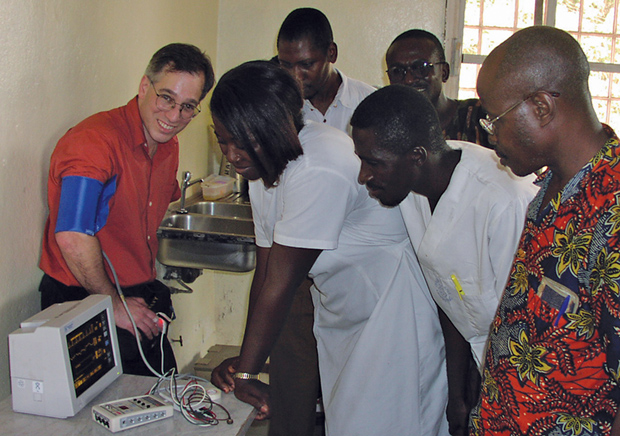
A New Generation Hungrier for Purpose
Robert Malkin, BME professor and founder of the Global Public Service Academies and Engineering World Health (EWH), which he founded along with engineering professor Mohammad Kiani in 2001 while at the University of Memphis, has also seen interest in his programs increase in recent years—while other similar programs continue to crop up. EWH now has 23 student chapters on four continents (Figures 2 and 3). “Among the young, the interest is growing tremendously,” he says. “Some of it, I’m sure, has a lot to do with awareness thanks to celebrity focus on what can be done in resource-poor settings. But if you look over the generations, this one is hungrier for a level of purpose in their lives, and they’re finding it through working.”
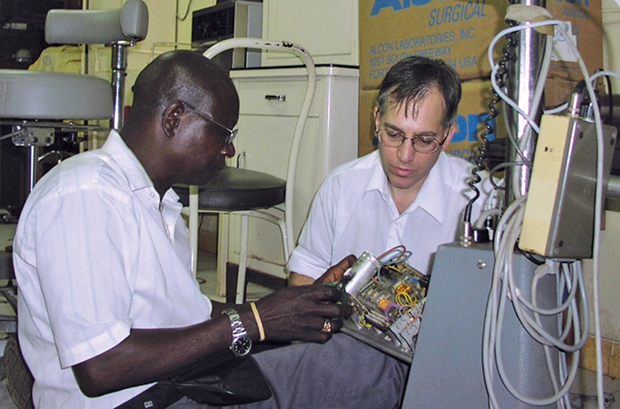
Amos Winter, an MIT professor and director of the Global Engineering and Research Lab, whose all-terrain wheelchair designed for developing countries won a 2010 R&D 100 Award and was named one of The Wall Street Journal’s top innovations in 2011, adds that emerging markets can be huge catalysts for global innovation because of the constraints and challenges they impose. For instance, he says, “If a poor African family makes 1/100th the salary an American might make, they don’t want 1/100th the quality of life.” People in these markets need performance that is not proportional to what they can afford to pay for the technology, so engineers must come up with low-cost alternatives to universal problems. “We do high-tech third-world stuff that can lead to high-tech first-world stuff,” he explains. “We focus most of our efforts on emerging markets and approach problems in those markets as rigorous engineering scientists, while taking into account the unique socioeconomic factors imposed by those markets. We’re trying to create technologies that are going to work in emerging markets but also are also relevant in wealthier markets, because everybody likes high performance at low cost.”



